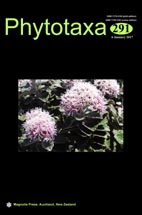Abstract
Asteraceae is the family with the highest species number in the rocky fields (campos rupestres) of the Chapada Diamantina, Bahia, Brazil. On the basis of several collections from this area, we are proposing a new genus of Asteraceae based on morphology and phylogeny, to accommodate a species newly described here. Lapidia apicifolia is a loosely ramified shrub 2–4 m high, stem tomentose, leaves opposite-decussate, laminae conduplicate, petiolate, receptacle flat, epaleaceous, glabrous, and pappus of bristles fused at base, irregular in length, fringed and purplish. In a phylogenetic analysis using sequence data from ITS and trnL-trnF of selected members of Eupatorieae, Lapidia is indicated as sister group of a highly supported clade with Morithamnus, Bahianthus and Catolesia. This group is composed by loosely branched shrubs, most with leaves that are lax, stems, leaves and involucral bracts that are viscid (Bahianthus and Morithamnus) and, if not, trichomes (tomentose indumentum) are developed (Lapidia), to protect against both solar radiation and loss of water. A description, illustrations, and a discussion about related and sympatric genera are presented.

